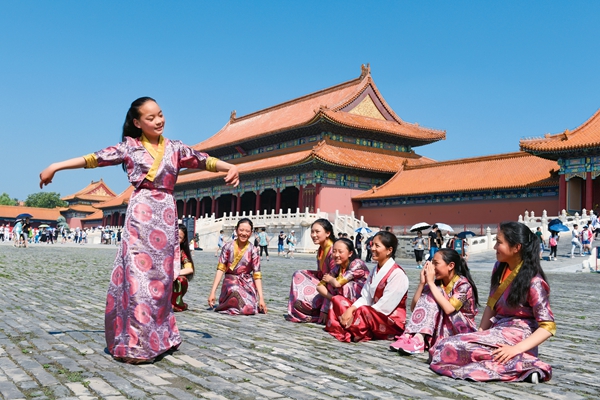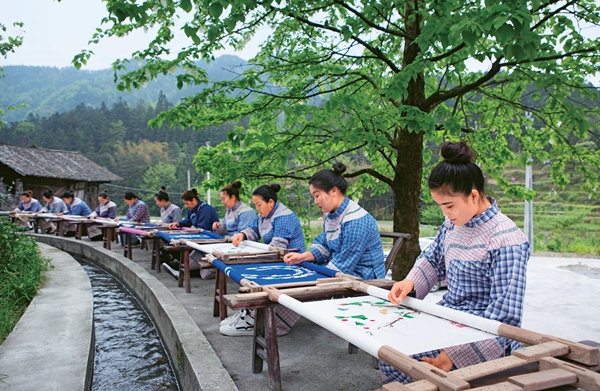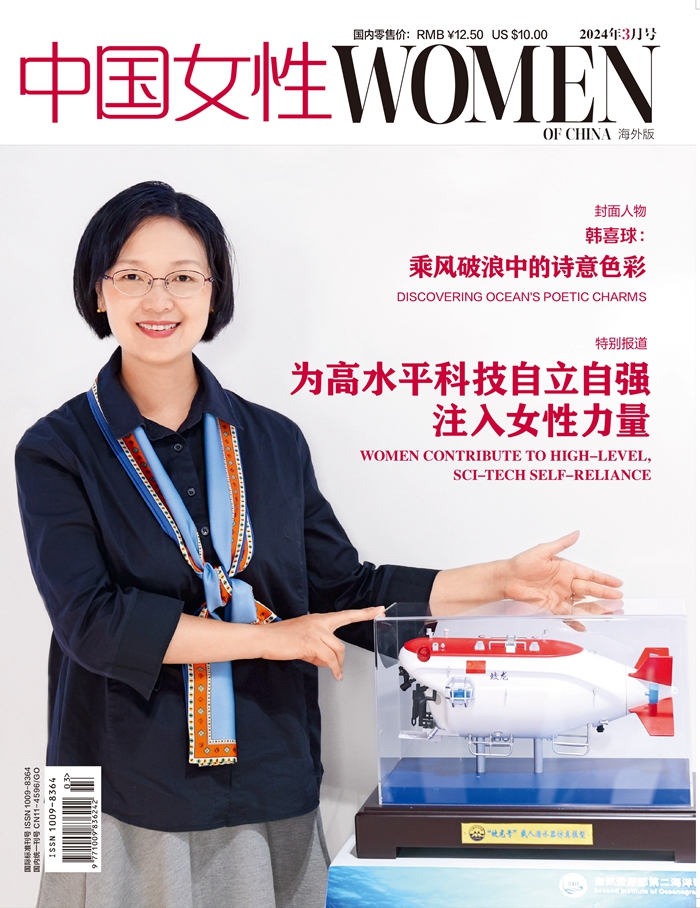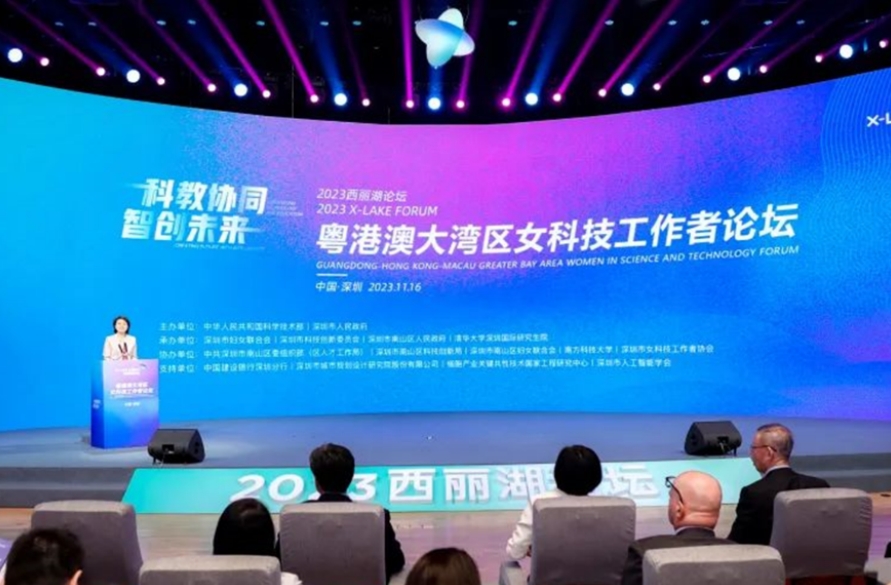China Making Great Strides in Women's Cause
"Development cannot be achieved without women, and the benefits it brings must be shared by all," Chinese President Xi Jinping said, during the Global Leaders' Meeting on Gender Equality and Women's Empowerment, at the United Nations headquarters in New York, the United States, on September 27, 2015. Since the 18th National Congress of the Communist Party of China (CPC), in November 2012, the CPC Central Committee, with Comrade Xi Jinping at the core, has attached great importance to the development of women's cause, and it has ensured women have been able to exercise their democratic rights, participate in economic and social development, and benefit from the outcomes of reforms and development on an equal and legal basis. The CPC Central Committee, with Comrade Xi Jinping at the core, has guided the development of Chinese women's cause in the right direction.
During the past decade, progress has been made in promoting the high-quality development of women's cause. Chinese women have followed the instructions and guidance of the Party, and they have responded to the call of Xi Jinping, General Secretary of the CPC Central Committee, to strive to undertake great causes, be advocates of civility and trailblazers in chasing their dreams.
 |
|
[China Children and Teenagers' Fund] |
Systematic Assurance
Wang Xiling, a National Poverty Alleviation Award winner, said, "What's more important is standing on your own two feet." During her transformation from an impoverished villager to president of an agricultural cooperative, she realized her entrepreneurship dream would not have been realized without the opportunities presented by the new era.
Since the 18th CPC National Congress, Xi's important instructions on women and women's work have pointed the way forward for the development of women's cause in China, especially during the new era.
Commitments to adhere to the basic State policy of gender equality, and to protect the legitimate rights and interests of women and children, were written into the reports of both the 18th and 19th CPC national congresses.
The decision adopted during the Fourth Plenary Session of the 19th CPC Central Committee stressed CPC's commitment to uphold and improve systems and mechanisms for promoting gender equality and women's all-round development. The Resolution of the Central Committee of the Communist Party of China on the Major Achievements and Historical Experience of the Party over the Past Century, adopted during the Sixth Plenary Session of the 19th CPC Central Committee, stressed the CPC's commitment to help strengthen family ties, values and traditions, and to better protect the rights and interests of women and children.
The 13th Five-Year Plan (2016-2020) for National Economic and Social Development and the 14th Five-Year Plan (2021-2025) for National Economic and Social Development included plans for promoting the development of women, children and families, and those plans helped lay the solid foundation for promoting women, children and families' development in step with economic and social development.
The National Working Committee on Children and Women under the State Council formulated the China National Program for Women's Development (2021-2030), through which the committee set goals and strategies for women's development in health, education, the economy and various other fields. Working committees on children and women, at various levels, have promoted implementation of the program. The working mechanism for promoting women's cause, which involves the guidance of Party committees, the responsibility of governments, the coordination of working committees on children and women, the cooperation of various departments, and the participation of all sectors of society, has been consolidated.
China has constantly cemented the legal assurance of gender equality and women's rights and interests. China has established a legal system, including more than 100 laws and regulations, to comprehensively protect women's rights and interests. The Civil Code, the first law to carry the title "code" in New China, which took effect on January 1, 2021, emphasizes the protection of women's rights and interests in marriage and family.
The Anti-Domestic Violence Law of the People's Republic of China, which took effect on March 1, 2016, protects women's personal rights in family. The Family Education Promotion Law of the People's Republic of China, which took effect on January 1, 2022, makes clear the State, schools and society provide guidance on and support and services for family education.
The Law on Rural Land Contracts of the People's Republic of China was amended in 2018 to improve the legal basis for protecting rural women's land rights and interests. Gender-equality-evaluation mechanisms have been established — at the national level and in 31 provinces, autonomous regions or municipalities — to reinforce the legal protection of women's rights and interests.
All-Round Development
Women's cause in China has enjoyed broad space for development, and has shown bright prospects, during the past decade. China has promoted women's access to basic medical insurance and social security, and supported women's participation in economic and social development.
For example, women's health has significantly improved; the average life expectancy of Chinese women is now 80.88 years (as of 2020), and the maternal mortality rate is down to 16.1 per 100,000 (since 2021).
China launched the program of free cervical and breast cancer screening for rural women in 2009. As of 2020, the program had provided free cervical cancer screening to an estimated 130 million women, and free breast cancer screening to approximately 64 million women.
Also during the past decade, women's roles (collectively) in economic and social development has become increasingly prominent. Shi Liping, an inheritor of Miao embroidery and a National March 8th Red-Banner Holder, has led women in starting businesses and/or finding employment. Between 2000 and 2008, she collected patterns and historical materials of Miao embroidery, and she established a team of embroiderers and a Miao culture tourism product development company in Songtao Miao Autonomous County, in Southwest China's Guizhou Province.
 |
| [China Women's Development Fund] |
The proportion of women in China's total employed population has remained above 40 percent during the past decade. Women have become an important force in mass entrepreneurship and innovation. Women in China now account for 55 percent of the country's Internet entrepreneurs. In 2021, women accounted for about 45.8 percent of the country's science and technology workers.
The development of education has helped Chinese women pursue their dreams. With the support of the Spring Bud Project, implemented by the China Children and Teenagers' Fund, Yuzhuoma, from Southwest China's Tibet Autonomous Region, has finished her education (from primary school to university). She became a soldier of the Air Force of the People's Liberation Army in 2011.
In addition, the gender gap in compulsory education has basically been eliminated in China. The proportion of girl students in colleges and universities now exceeds 50 percent. As women become more educated, they are more confident in pursuing excellence in life.
Women have been widely participating in decision-making, the democratic management in enterprises and the management of grassroots democracy during the past decade.
Statistics indicate women deputies to the 13th National People's Congress (NPC) accounted for 24.9 percent of the total number of NPC deputies, and women members of the 13th National Committee of the Chinese People's Political Consultative Conference (CPPCC) accounted for 20.4 percent of the total number of CPPCC members. The term of the 13th NPC deputies and 13th CPPCC National Committee members is 2018-2023.
After the elections of the "two committees (village Party branch and the village committee)" were held earlier this year, each village in China had at least one woman on the "two committees." About half of the members of neighborhood committees are women.
Social security for women continues to improve. At the end of 2020, the number of women participating in maternity insurance was 103 million, an increase of 49.31 million compared with 2010. Further, 650 million women were covered by basic medical insurance.
Such statistics indicate Xi's major deployments are having the desired impact. "We must buttress women's capacity to play their part in society and the economy, enhance women's capability in decision-making and management, and support them in becoming leaders in the fields of politics, business and academia," Xi told the Global Leaders' Meeting on Gender Equality and Women's Empowerment.
Countless Chinese women are leaving their mark on society. For example, 10 years after her first space mission, Liu Yang, China's first woman astronaut, returned to space; only this year (on June 5), she entered the country's space station core module, Tianhe. In 2021, Zhang Guimei, a teacher who established China's first all-girls' high school, and who helped about 2,000 girls receive a higher education, received the July 1 Medal, the highest honor of the CPC. Liu and Zhang are among the examples of Chinese women in the new era who continue to strive forward and make contributions in rural revitalization, scientific and technological innovation, epidemic prevention and control, and grassroots governance.
 |
| Shi Liping, an inheritor of Miao embroidery and a National March 8th Red-Banner Holder, has established a team of embroiderers and a Miao culture tourism product development company in Songtao Miao Autonomous County, in Southwest China's Guizhou Province. [Photo supplied by Shi Liping] |
Reform and Innovation
Officials with the All-China Women's Federation note, beginning with the pilot reform projects by the women's federations in Shanghai and Chongqing in 2016, women's federations, at all levels across the country, have deepened reform.
The working mechanism used by the women's federations to guide, serve and contact women has been constantly improved. Such endeavors have made the work of women's federations more politically responsive, up to date, and geared to the demands of the masses.
Women's federations have also made innovations in their work as they have guided women. During the past decade, women's federations have conducted various publicity and education activities, both online and offline, and they have called on women to learn from outstanding women role models, and to unite and lead women to follow the instructions and guidance of the Party.
To serve the overall development of the country, women's federations have implemented various actions in poverty alleviation, rural revitalization, entrepreneurship and innovation, and scientific and technological innovation. They have organized more than 200,000 technical training courses in rural areas, they have trained nearly 20 million women, and they have helped more than 5 million women increase their incomes.
Women's federations have implemented the Family Happiness and Well-Being Campaign and the Healthy China — Mother Action, and they have organized annual activities to identify the most beautiful families.
By the end of 2021, some 13.17 million families had been selected most beautiful families, by women's federations, at all levels, and in all regions, and 5.53 million families had been selected five-virtue families.
Women's federations have built a nation-wide family education guidance and service network, and they have established more than 410,000 parents' schools and attracted 280 million parents and children to participate in parent-child reading activities. The federations have also maintained friendly relationships with more than 420 organizations and institutions in 145 countries.
Women's federations across China have also participated in the formulation and revision of the Civil Code, the Law on the Protection of Women's Rights and Interests of the People's Republic of China, and various other laws and policies, and they have helped promote implementation of the Anti-Domestic Violence Law of the People's Republic of China and the Family Education Promotion Law of the People's Republic of China. The federations have also established and improved a comprehensive rights-protection service model that integrates conflict investigations, dispute mediation, legal assistance and caring services.
Efforts to reform grassroots women's federations have been implemented well. By the end of 2021, grassroots women's federations had more than 7.7 million members, combined, on their executive committees. Women's federations, at all levels, had established more than 700,000 women's homes across the country.
The road ahead is long; therefore, continuing to strive together is the only way forward. Chinese women, united as one, are marching forward, in high spirits, and they are making greater achievements in the new era.
(Source: People's Daily/Women of China English Monthly October 2022 issue)
Please understand that womenofchina.cn,a non-profit, information-communication website, cannot reach every writer before using articles and images. For copyright issues, please contact us by emailing: website@womenofchina.cn. The articles published and opinions expressed on this website represent the opinions of writers and are not necessarily shared by womenofchina.cn.








 WeChat
WeChat Weibo
Weibo 京公网安备 11010102004314号
京公网安备 11010102004314号